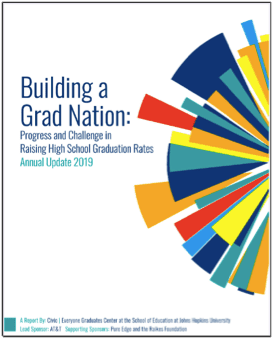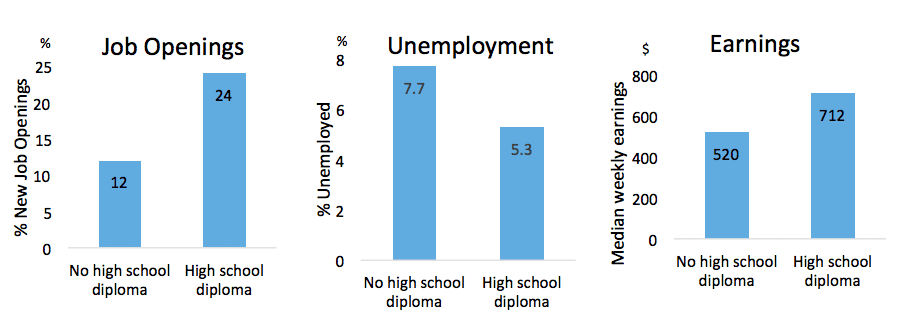
Rebecca Lavinson, AYPF Policy Associate
The end of June means one thing for high school students: the beginning of summer vacation. Students full of anticipation and excitement fidget at their desks during their last classes of the year, waiting for the final bell to ring to be released into the warm weather and approximately 12 weeks of summer break. The month of June is cause for even greater celebration among high school seniors who will be handed their diploma, officially finished with their secondary education. That is, for the 85% of high school seniors who graduate.
Who is graduating, and who is being left behind?
High school graduation rates are some of the highest they have been across the country. The average public high school graduation rate was 85% in 2017, with Iowa (91%) and New Jersey (91%) leading all other states. More encouragingly, the largest increases in graduation rates since 2011 have been driven by increases in the graduation rate of disadvantaged groups. The largest increases in graduation rates are from Blacks (11%), Hispanics (9%), English Learners (9%), low-income students (8%), and students with disabilities (8%) compared to a 6% overall increase in graduation rates.
While many states should be commended for their high graduation rates and narrowing achievement gaps, it is just as important to celebrate the gains as it is to understand which students are still not walking across the stage during the graduation ceremony to collect their diploma. The students who are left out of the 4 year public high school graduation rate include 20% of Hispanics and 22% of Blacks compared to just 11% of Whites and 9% of Asians; 33% of students with disabilities; and 22% of students who are economically disadvantaged.
 Discrepancies in graduation rates are large between schools. A report by Grad Nation states that we are living in “two educational nations” where the majority of schools have a graduation rate of over 90% while a minority of schools are responsible for the bulk of the low graduation rates. There were 2,357 low-graduation-rate schools, or schools that graduate less than two-thirds of their students, in 2017. While these schools enroll only 6.5% of the student population, they account for 31% of all four-year non-graduates. One of the biggest challenges that low-graduation-rate schools and school districts face is that the demographics of these schools are disproportionately black, Hispanic, low-income, and are primarily located within impoverished communities which need the most resources but receive the fewest (Grad Nation, 2019).
Discrepancies in graduation rates are large between schools. A report by Grad Nation states that we are living in “two educational nations” where the majority of schools have a graduation rate of over 90% while a minority of schools are responsible for the bulk of the low graduation rates. There were 2,357 low-graduation-rate schools, or schools that graduate less than two-thirds of their students, in 2017. While these schools enroll only 6.5% of the student population, they account for 31% of all four-year non-graduates. One of the biggest challenges that low-graduation-rate schools and school districts face is that the demographics of these schools are disproportionately black, Hispanic, low-income, and are primarily located within impoverished communities which need the most resources but receive the fewest (Grad Nation, 2019).
The value of a high school diploma
Now more than ever, a high school diploma is necessary for accessing a number of postsecondary opportunities, from continuing education to employment.
“A high school diploma is no longer the end point, but the jumping off point.”
-Robert Balfanz
Not obtaining a high school diploma can have lifelong consequences including fewer employment prospects, a greater likelihood of being unemployed, and lower earnings.

*Sources: Georgetown University, Center on Education and the Workforce; BLS1; BLS2
Why aren’t students graduating?
The report Don’t Call Them Dropouts by America’s Promise Alliance found that many high school students who leave school do so due to external factors, including life circumstances, home environments, and lack of support systems.
When selecting all reasons that apply for leaving school, some of the top reasons students cited were: school was not relevant to their lives (20%), they needed to make money to support their family (19%), and no one cared if they attended (18%). Many of the reasons for leaving school were not selected in isolation, and the authors of the report determined that students who leave high school often do so for multiple reasons as opposed to a single dominant factor.
Students who returned to school were also surveyed. When asked their reasons for returning to school, 41% said it was because someone encouraged them to return, 32% said it was because they had the time, and 28% said it was because their family supported them. Providing students with supports within schools that help them overcome their own, unique external circumstances could not only be used to reengage students who have left school, but also prevent them from leaving in the first place.
Steps for supporting low-graduation-rate schools and at-risk students
Although there is no simple fix for reducing the number of students who leave high school, there are several actions states can take to reduce the school-leaving rate among students who are facing adverse external factors. Below are steps that states and schools can take to support low-graduation-rate schools and at-risk students:
1) Identify low-graduation-rate schools
Low-graduation-rate schools and districts need the most attention and resources to improve their graduation rates. Each state should start by identifying the schools and districts most in need of support. Under ESSA, states have already identified 1,805 low-graduation-rate high schools for support.
2) Develop individualized plans of action for schools
Once the schools and districts are identified, states can then develop individualized plans of action that schools and districts can follow to improve their graduation rates. The 2019 Grad Nation report specifically recommends that states develop “Closing the Grad Gap on the Path to 90 Plans.”
3) Provide extra resources to low-graduation-rate schools
Low-graduation-rate schools catering to the students most in need require additional resources. By providing greater financial resources through weighted funding formulas, states can distribute more funding to schools serving students with greater needs. Additionally, state leaders should work with schools and school districts to decide where to allocate the funding to have the greatest impact on improving the graduation rates of students most in need.
4) Create clear pathways for students to reach graduation
Many schools and school districts have numerous pathways that students can follow to acquire the coursework they need to graduate. States should ensure that pathways to graduation are clear to students, and have advisors available to guide students and indicate which courses they need to take not only to graduate, but to graduate college and career ready.
5) Develop early warning systems to identify at-risk students
The most at-risk students need the most supports. While school-based early warning systems have already been developed to identify students who are not performing well academically, schools should be creating similar systems to identify students that are at risk of dropping out due to factors outside of the school building. Early warning systems can be used to pinpoint risk factors including housing instability, loss of a family member, or financial needs.
6) Enhance student supports for at-risk students through building relationships
Once at-risk students are identified, they should be given the appropriate supports to stay in school and graduate. Fostering meaningful relationships with attentive and caring adults can be enough to increase student persistence through high school.
Looking ahead to future graduation ceremonies
States have made progress in improving high school graduation rates, which reached an all-time high in 2017. However, states need to continue working to accelerate this progress and narrow the achievement gap. Many at-risk populations are still being overlooked. Homeless youth, for example, may have the lowest graduation rates of any subgroup of students, with graduation rates well below that of low-income students. As John B King, former United States Secretary of Education said, “We can’t get to our goal unless we figure out how to best support our most vulnerable students.” By targeting supports to the students and schools most in need, states can help improve every high school students’ chances of walking across the stage in June of their senior year to collect their diploma.





